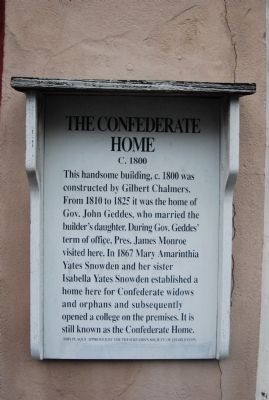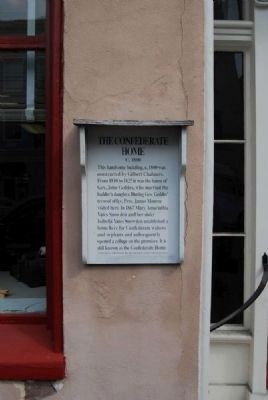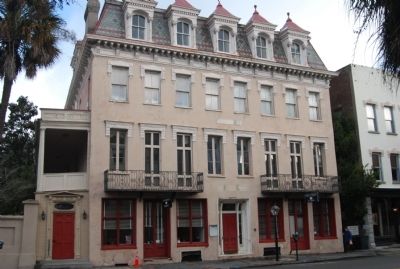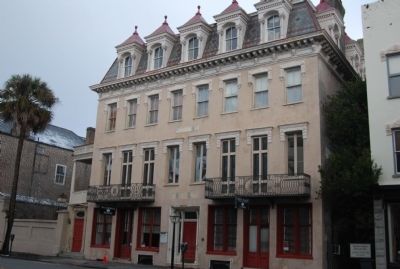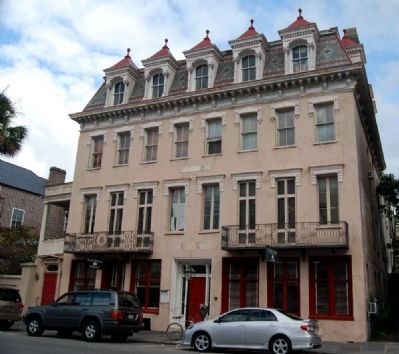French Quarter in Charleston in Charleston County, South Carolina — The American South (South Atlantic)
The Confederate Home
c. 1800
This handsome building, c. 1800 was constructed by Gilbert Chalmers. From 1810 to 1825 it was the home of Gov. John Geddes, who married the builder's daughter. During Gov. Geddes' term in office, Pres. James Monroe visited here. In 1867 Mary Amarinthia Yates Snowden and her sister Isabella Yates Snowden established a home here for Confederate widows and orphans and subsequently opened a college on the premises. It is still known as the Confederate Home.
Erected by Preservation Society of Charleston.
Topics and series. This historical marker is listed in this topic list: War, US Civil. In addition, it is included in the Former U.S. Presidents: #05 James Monroe, and the South Carolina, Preservation Society of Charleston series lists. A significant historical year for this entry is 1800.
Location. 32° 46.599′ N, 79° 55.797′ W. Marker is in Charleston, South Carolina, in Charleston County. It is in the French Quarter. Marker is on Broad Street, 0.1 miles west of Church Street, on the left when traveling east. Touch for map. Marker is at or near this postal address: 64-60 Broad Street, Charleston SC 29401, United States of America. Touch for directions.
Other nearby markers. At least 10 other markers are within walking distance of this marker. Daniel Ravenel II House (within shouting distance of this marker); Clark Mills Studio (within shouting distance of this marker); Old Bank Building (within shouting distance of this marker); Site of the William Burrows House (within shouting distance of this marker); Francis Salvador (within shouting distance of this marker); Henry Timrod (within shouting distance of this marker); P.G.T. Beauregard (within shouting distance of this marker); Bible Depository (within shouting distance of this marker); Washington Light Infantry Monument (within shouting distance of this marker); Prayer Composed By Ellison Capers (within shouting distance of this marker). Touch for a list and map of all markers in Charleston.
Also see . . .
1. John Geddes. John Geddes (December 25, 1777 – March 4, 1828) was the 47th Governor of South Carolina from 1818 to 1820. (Submitted on October 3, 2011, by Brian Scott of Anderson, South Carolina.)
2. John Geddes. Preservation Society of Charleston information on Geddes and the Confederate Home. (Submitted on December 12, 2011, by Brian Scott of Anderson, South Carolina.)
3. Mary Amarinthia Yates Snowden - Find-a-Grave Memorial. She was born on September 10, 1819 in Charleston, SC to Joseph and Elizabeth Ann Saylor Yates. (Submitted on October 3, 2011, by Brian Scott of Anderson, South Carolina.)
Additional commentary.
1. Confederate Homes 60-64 Broad Street
This large complex stretches through the block from Broad Street to Chalmers Street and is a nineteenth-century amalgamation of several different properties and buildings. On the site of a house formerly leased to a royal lieutenant governor the core of the front portion was built by Gilbert Chalmers, a well-to-do house carpenter, as a double tenement. Inherited by Chalmers' daughter and her husband, Gov. John Geddes of Ashley Hall Plantation, the building houses President James Monroe when he spent several weeks in Charleston in 1819. Forced by debt to sell, Geddes conveyed this building in 1825. By 1834 the Geddes House had passed to Angus Stewart, who converted it to the Carolina Hotel. Subsequent additions to the rear were later connected to an early-nineteenth-century tenement at 23-25 Chalmers Street, the western side of which had served as the U.S. District Court from 1845 to 1860. It was here at the time of South Carolina's secession from the Union that District Judge Andrew G. Magrath took off his robes and suspended the Federal Court in South Carolina. As early nineteenth-century doctor's office, adapted to modern office use and almost entirely reconstructed after Hurricane Hugo, stands on the southeastern edge of the site at 66 Broad Street.
In 1867 the entire property was leased to Mrs. Amarinthea Yates Snowden and a group of nine widows, who organized the Home for Mothers, Widows and Daughters of Confederate Soldiers of Charleston. By 1880 the home houses several hundred aged or infirm windows and a teacher's college for fifty-two women. After heavy damage in the earthquake of 1886, repairs were completed and the Broad Street facade was remodeled in the Second Empire style with a mansard slate roof and pressed metal dormers and cornices. Of particular interest from the street are the original wrought-iron balconies on the second floor and the mid-nineteenth-century storefronts below. (Source: The Buildings of Charleston: A Guide to the City's Architecture by Jonathan H. Poston (1997) pgs 162-163.)
— Submitted October 3, 2011, by Brian Scott of Anderson, South Carolina.
Credits. This page was last revised on February 16, 2023. It was originally submitted on February 14, 2010, by Michael Sean Nix of Spartanburg, South Carolina. This page has been viewed 2,528 times since then and 85 times this year. Photos: 1. submitted on February 14, 2010, by Michael Sean Nix of Spartanburg, South Carolina. 2. submitted on October 3, 2011, by Brian Scott of Anderson, South Carolina. 3, 4. submitted on February 14, 2010, by Michael Sean Nix of Spartanburg, South Carolina. 5. submitted on October 3, 2011, by Brian Scott of Anderson, South Carolina. • Craig Swain was the editor who published this page.
